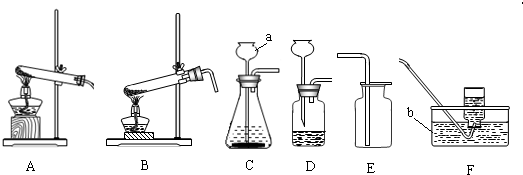问题
问答题
通过一年的化学学习,相信你已掌握了实验室制取气体的有关规律,请你结合下列装置图和所给试剂填空:

试剂:高锰酸钾、大理石、稀盐酸
(1)写出图中标号所指仪器的名称.a______,b______.
(2)填表:(提示:所选装置填序号)
| 制取气体 | 化学方程式 | 制取装置 | 收集装置 |
| 氧气 | |||
| 二氧化碳 |
答案
(1)熟记常用的仪器名称:图中标号a长颈漏斗,b水槽;
(2)①可选取由加热装置的A用高锰酸钾制取氧气;根据氧气的密度和水溶性,收集可选取向上排空气法或排水法;
②制取二氧化碳:块状碳酸钙与液体反应,不需要加热,可选取C或D制取,因为二氧化碳可溶于水,收集只能选取向上排空气法.
故答为:(1)长颈漏斗、水槽;
(2)
| 制取气体 | 化学方程式 | 制取装置 | 收集装置 | ||||
| 氧气 | 2KMnO4
| A | E或F | ||||
| 二氧化碳 | CaCO3+2HCl═CaCl2+H2O+CO2↑ | C | E |
